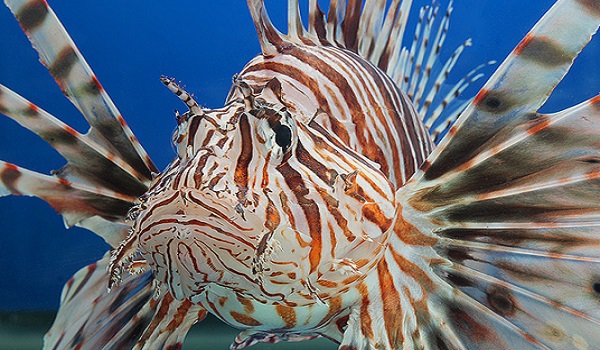The red lionfish (Pterois volitans) belongs to the pteroinae genus which has 10 species of lionfish. Two of them, Pterois volitans and Pterois miles, are invasive species in the North West Atlantic Ocean and the Caribbean. Of the two species Pterois volitans makes up 90% of the total.
0
Taxonomy
- Kingdom: Animalia
- Phylum: Chordata
- Class: Actinopterygii
- Order: Scorpaeniformes
- Family: Scorpaenidae
- Genus: Pterois
- Species: Pterois volitans
0
Name
- Scientific name: Pterois volitans.
- Common name: Red lionfish, red firefish, turkefish, zebrafish.
Distribution and Habitat
- The lionfish is a marine species native to the Indo-Pacific Ocean covering most of Oceania east to French Polynesia.
- It is a popular aquarium species all over the world and it has spread to new marine environments through the aquarium trade.
- It was introduced to the east coast of the United States ranging from Florida to New Jersey and to the Gulf of Mexico. Red lionfish have also expanded to the Caribbean.
- The lionfish is a tropical fish living in waters between 71.6˚F and 4˚F or 22˚C and 28˚ C. They have adapted well to lower water temperatures in the U.S. between 57.2˚F and 75.2˚F or 14˚C to 24˚C.
- They swim at depths of 10 to 175 meters near coral reefs and rocky reefs.
Physical Features
- The red lionfish is a distinctive member of the scorpiofish family known for their camouflage. However lionfish do not share this characteristic; on the contrary, it has an attractive coloration which warns predators of its venom.
- They have red and white vertical stripes that give it the name of zebrafish. The vertical stripes alternate from wide to thin.
- Their fan-like pectoral fins give it the name turkeyfish.
- Lionfish have 13 elongated dorsal fin spines, 10 dorsal soft rays, 3 anal spines and 6 to 7 anal soft rays. The membranes of the dorsal, caudal and anal fins are spotted.
- Venom is delivered by the spines and it is produced by glands at the base of its spines.
- Its venom can cause cardiovascular and neuromuscular effects ranging from swelling to paralysis.
Red lionfish from the London Aquarium
Weight and Length
- The lionfish length ranges from 11.8 to 15 inches or 30 to 38 cm.
- Its maximum weight is 2.65 lbs or 1.2 kg.
- Scientists have observed that they are larger in its introduced ranges.
Behavior
- Adult lionfish are solitary animals unless when mating. Juveniles live in small groups.
- During the day they look for shelter under ledges or caves where they stand motionless with its head tilted downward.
- Once they find a suitable habitat they tend to stay there. Densities can reach to more than 200 lionfish per acre.
- In order to hunt lionfish blow water at its prey to disorient it. It corrals its prey by spreading its pectoral fins and swallows it in a single motion.
Reproduction
- Female releases 2 gelatinous egg clusters, each one having from 2,000 to 15,000 eggs which are externally fertilized by a male.
- They can spawn every 4 days in warm water.
- Eggs hatch within 36 hours after fertilization.
- The larvae become swimmers 2 to 3 days after hatching.
Diet
- They eat small fish, shrimps and crabs. They actively hunt at night.
- Larger lionfish resort to cannibalism eating smaller lionfish.
- In its introduced range lionfish eat shrimp, yellowtail snapper, Nassau grouper.
Life Expectancy
- Lionfish can live up to 15 years in the wild.
Invasive Species
- The lionfish in its non native range is considered an invasive species.
- In the east coast of the U.S. and the Caribbean it is spreading rapidly to new marine environments competing for food with native species.
- It is the first non native species to establish in the western north Atlantic and the Caribbean.
- It has the potential to displace local species and disrupt the marine ecosystem by diminishing its biodiversity with the possibility of extinction of several species.
- They can drastically reduce native fish species due to lack of natural predators and their voracious appetite. Lionfish are known to eat native fish and crustaceans in large quantities, especially economically important species.
- Its venom is dangerous to divers and snorkelers affecting tourism in the area.
- Lionfish wounds are treated by immersing the body area in hot water for 30 to 90 minutes. Venom is neutralized by heat.
Conservation Status
- The red lionfish has not been assessed by the IUCN Red List of Threatened Species because it exists in healthy numbers.
Did you know?
- The first documented case of release of lionfish in the United States was in 1992. It resulted from the destruction of a large aquarium by Hurricane Andrew.
References and further research
Smithsonian marine station at Fort Pierce
Global invasive species database – Pterois volitans
USSG-non indigenous aquatic species
Ichthyology at the Florida Museum of Natural History – Pterois volitans
National Centers for Coastal Ocean Science –Lionfish
REEF – Lionfish Research Program
Florida Fish and Wildlife Conservation Commission –Lionfish Frequently Asked Questions
Other links


